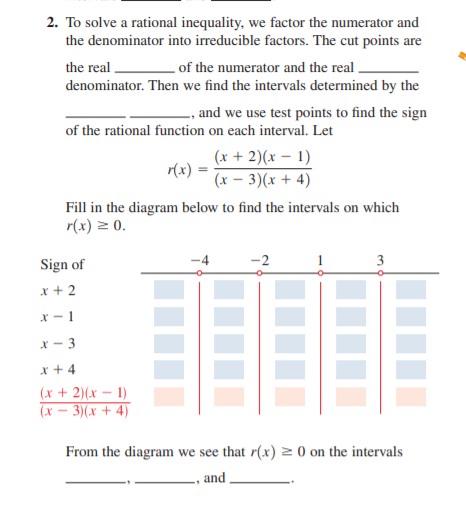2. To solve a rational inequality, we factor the numerator and the denominator into irreducible factors. The cut points are the real of the numerator and the real. denominator. Then we find the intervals determined by the -, and we use test points to find the sign of the rational function on each interval. Let (x + 2)(x – 1) r(x) = (x – 3)(x + 4) Fill in the diagram below to find the intervals on which r(x) 2 0. 3 Sign of x + 2 x - 1 x - 3 x + 4 (x + 2)(x – 1) (x – 3)(x + 4) From the diagram we see that r(x) 2 0 on the intervals , and
2. To solve a rational inequality, we factor the numerator and the denominator into irreducible factors. The cut points are the real of the numerator and the real. denominator. Then we find the intervals determined by the -, and we use test points to find the sign of the rational function on each interval. Let (x + 2)(x – 1) r(x) = (x – 3)(x + 4) Fill in the diagram below to find the intervals on which r(x) 2 0. 3 Sign of x + 2 x - 1 x - 3 x + 4 (x + 2)(x – 1) (x – 3)(x + 4) From the diagram we see that r(x) 2 0 on the intervals , and
Chapter3: Polynomial Functions
Section3.2: Polynomial Functions Of Higher Degree
Problem 3ECP
Related questions
Question
To solve a rational inequality, we factor the numerator and
the denominator into irreducible factors. The cut points are
the real of the numerator and the real
denominator. Then we find the intervals determined by the
, and we use test points to find the sign
of the rational function on each interval. Let

Transcribed Image Text:2. To solve a rational inequality, we factor the numerator and
the denominator into irreducible factors. The cut points are
the real
of the numerator and the real.
denominator. Then we find the intervals determined by the
-, and we use test points to find the sign
of the rational function on each interval. Let
(x + 2)(x – 1)
r(x) =
(x – 3)(x + 4)
Fill in the diagram below to find the intervals on which
r(x) 2 0.
3
Sign of
x + 2
x - 1
x - 3
x + 4
(x + 2)(x – 1)
(x – 3)(x + 4)
From the diagram we see that r(x) 2 0 on the intervals
, and
Expert Solution
This question has been solved!
Explore an expertly crafted, step-by-step solution for a thorough understanding of key concepts.
This is a popular solution!
Trending now
This is a popular solution!
Step by step
Solved in 3 steps

Knowledge Booster
Learn more about
Need a deep-dive on the concept behind this application? Look no further. Learn more about this topic, algebra and related others by exploring similar questions and additional content below.Recommended textbooks for you


Calculus For The Life Sciences
Calculus
ISBN:
9780321964038
Author:
GREENWELL, Raymond N., RITCHEY, Nathan P., Lial, Margaret L.
Publisher:
Pearson Addison Wesley,

Algebra: Structure And Method, Book 1
Algebra
ISBN:
9780395977224
Author:
Richard G. Brown, Mary P. Dolciani, Robert H. Sorgenfrey, William L. Cole
Publisher:
McDougal Littell


Calculus For The Life Sciences
Calculus
ISBN:
9780321964038
Author:
GREENWELL, Raymond N., RITCHEY, Nathan P., Lial, Margaret L.
Publisher:
Pearson Addison Wesley,

Algebra: Structure And Method, Book 1
Algebra
ISBN:
9780395977224
Author:
Richard G. Brown, Mary P. Dolciani, Robert H. Sorgenfrey, William L. Cole
Publisher:
McDougal Littell

Algebra & Trigonometry with Analytic Geometry
Algebra
ISBN:
9781133382119
Author:
Swokowski
Publisher:
Cengage

Big Ideas Math A Bridge To Success Algebra 1: Stu…
Algebra
ISBN:
9781680331141
Author:
HOUGHTON MIFFLIN HARCOURT
Publisher:
Houghton Mifflin Harcourt

Algebra for College Students
Algebra
ISBN:
9781285195780
Author:
Jerome E. Kaufmann, Karen L. Schwitters
Publisher:
Cengage Learning